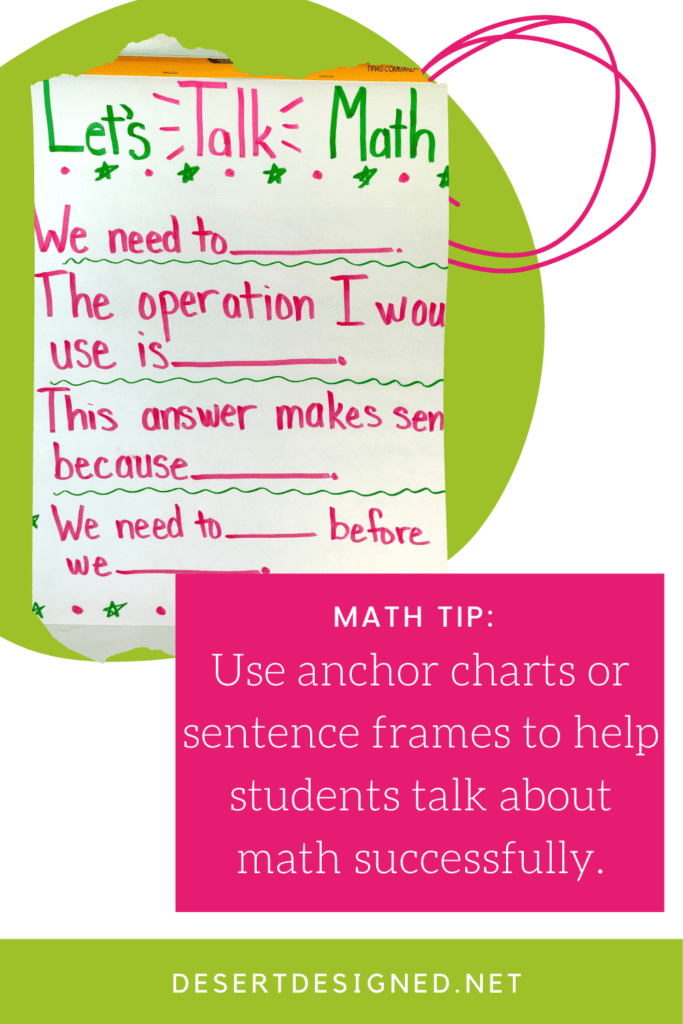Talking about math can be hard. Many people (teachers included) have a very difficult time feeling confident when it is time to express mathematical ideas using words. They may get nervous, lack the confidence to express their ideas clearly, or be lacking the vocabulary knowledge to explain their thinking. I can help with several tips for getting elementary students to talk about math confidently!

Get Kids Talking About Math
There are many ways you can get your kids talking about math in ways that they can be successful and feel confident outside of formal number talks or math talks!
Start Small
If you work with students who have not been trained from a young age to talk about their mathematical thinking, you will need to take baby steps. To many students, talking about their math strategies and thought processes seems completely foreign. It can also be a huge source of anxiety for math-averse students. If you think about it, this makes sense. Learning to talk math is like learning another language.
So, how do we help students overcome these struggles? Start small. Have students describe a basic math fact problem using words. For example, I may write 1+1 on the board and ask students to describe this math problem. They usually think I’m pretty silly and are able to do that with ease.
The next step is to turn the basic problem into a word problem. For example, I have one cookie and Sammy gives me one more. How many cookies do I have now? Students can usually describe that you need to add one and one to get two.
From there, you can just replace the ones in the problems above with more realistic numbers for your grade level. 1 + 1 becomes 2.35 + 1.7. The word problem becomes: I have 2.35 meters of yarn and Sammy gives me 1.7 meters of yarn. How much yarn do I have now?
By slowly transitioning into using more complex numbers, students will feel less intimidated by the discourse process and more comfortable using words to explain their mathematical thinking.
Model Math Discussions
If your students are stuck, providing a model for what math talk looks like can be a great place to start. One creative way to do this is to invite another staff member into your room to model this with you. You could invite an instructional coach, another teacher, instructional aide, or even a school administrator in to help! (Pro tip: school admin will love adding this into your eval!)

Once you are ready to go, pose a word problem for the class to see, and begin having a discussion with your discourse partner. Read the problem out loud and talk out how you would approach the problem. You will likely need to do this multiple times before students feel comfortable doing talking about the math with you, especially if they are not used to sharing their mathematical thinking out loud.
Types of Math Conversations to Model
- Explaining thinking through a math problem to the class
- Talking out how to solve a problem with a partner
- Talking in a small group about a math strategy
- Talking to self to solve a problem
Use Manipulatives to Encourage Talking About Math
Once kids are comfortable using words to talk about simple math problems, it is time to get them talking about the actual process and foundation behind the math they are doing. Have students use manipulatives to demonstrate a particular math problem.
In fifth grade, we spend a lot of time working on volume. I love using cubes to help students visualize the volume before we move into strictly numbers. To get students talking about their rectangular prisms, I allow students to build any rectangular prism they would like and then they need to describe what they have built to a partner.
Often, they want to say things like, “It’s a box,” or “It has 12 cubes.” This is a start, so we honor their thinking, but then push them to the next step. Think about asking them questions to push their thinking further. “That’s a great box. How many cubes high is the box?” “What is the width of your box?” The important thing now is to make sure they answer in complete sentences. They will want to say, “Three.” Help guide them into saying, “My box is three cubes wide” instead.
Notice how I include the preferred math vocabulary in how I respond to the students. By doing this, the students will hear the vocabulary terms used correctly in context. It will help them become more comfortable using the language of math in their own speaking.
By using manipulatives, students have something concrete in front of them to talk about and refer to. It makes the process more concrete and less abstract. Developmentally, the majority of elementary school students are not ready to think abstractly about most concepts.
Ask Guiding Questions in Talking with Kids about Math
Asking guiding questions to get kids talking more deeply about math is extremely important. Kids will often feel like they can answer your direct question more smoothly than invent all the words themselves.
I have worked with many teachers who feel that this is doing too much leading, but think of it more as scaffolding for their thinking. Guide students’ thinking along by using questions. Also, require all responses to you to be in complete sentences. Your math lessons may seem slow and take long early in the year. However, as the students get the hang of your expectations for their mathematical discourse, talking about math will come naturally for them as the school year progresses.
Guiding Questions Example
Let’s say students are given the following problem:
Here are some questions you can lead students through answering to get them talking about HOW to solve the problem, not just to state the answer. I have followed each question with an ideal student response as a complete sentence.
- How far does Wendy need to run this week?
- Wendy needs to run a total of five miles.
- How far did Wendy run on Monday?
- Wendy ran 2 ⅓ miles on Monday.
- How far did Wendy run on Wednesday?
- Wendy ran 1 ½ miles on Wednesday.
- What do we need to discover in this problem?
- We need to discover how much further Wendy needs to run and how far she has already run.
- How will we find out how far Wendy has run so far?
- We need to add how far Wendy ran on Monday to how far she ran on Wednesday.
- We need to find the sum of her distances from Monday and Wednesday.
- How do we figure out how much more Wendy needs to run?
- We need to subtract the amount she ran so far from her goal of five miles.
Talking through the math process help students learn to articulate their mathematical thinking. Additionally, the process above is invaluable for helping students to dissect a word problem!
Use Sentence Frames to Help Students Get Started Talking About Math
You may be thinking, this sounds great so far, Angela, but how do I get the kids to actually talk in complete sentences? I can’t break them out of just giving me numbers. By providing the students with sentence frames, you will set them up for success. They will likely rely on the frames for a while, but after some time, you (and they) will suddenly realize they aren’t using them anymore! And they will actually be using their own sentences.

Sentence frames can be posted in the form of posters, an anchor chart, added to student notebooks, or even printed and put onto a binder ring for quick student reference.
Prepare Students to Talk About Math with Explicit Vocabulary Instruction
Words that describe the answer to a math problem and the operations used to arrive at the answer are key elements to talking about mathematical thinking. Many students tend to confuse these vocabulary terms. By explicitly teaching this math vocabulary, you will be setting students up for ultimate success. Next week, I’ll be posting about how to effectively teach explicit math vocabulary! Be sure to subscribe to my mailing list to stay updated on recent posts!
Expressing the Problem Without Using Numbers in Math Talks
Thinking back to the list of guiding questions I gave you earlier, you may have realized that none of the student answers actually used numbers. If a student can express their thinking about a word problem without using any numbers, you can tell that they truly understand the content and process you are trying to teach.
I have noticed that when students use numbers to describe how to solve a word problem, often, they don’t even read the problem carefully. They just skim the problem for the given numbers and guess the correct operation. It is easy to see that a word problem has a 5 and a 3 in it, and say, “Three plus five.” It takes another level of thinking to say, “I need to add the carrots harvested on Monday to those harvested on Tuesday to get the total.”
If you frequently have your students practice talking about word problems and how to solve them without using any numbers, you will notice that they are able to more easily identify how to solve other problems as well!

What Next?
The key to making meaningful math conversations in your classroom successful is consistency. Establish a routine of getting kids talking and keeping kids talking about math. Set forth expectations of how you want kids to talk about math in your classroom and when they are talking, what that should sound like.
After all of these expectations and routines have been established, keep them going by reminding students, modeling these behaviors yourself, and brining attention to positive examples you notice as kids work. Not only will students feel more confident about their math thinking, you will notice relationships throughout your classroom improving as well!
Click here to learn more about establishing positive relationships with students in your classroom!



